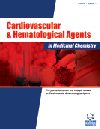
Full text loading...
We use cookies to track usage and preferences.I Understand
Glioblastoma multiforme (GBM) is characterized by massive tumor-induced angiogenesis aiding tumorigenesis. Vascular endothelial growth factor A (VEGF-A) via VEGF receptor 2 (VEGFR-2) constitutes majorly to drive this process. Putting a halt to tumor-driven angiogenesis is a major clinical challenge, and the blood-brain barrier (BBB) is the prime bottleneck in GBM treatment. Several phytochemicals show promising antiangiogenic activity across different models, but their ability to cross BBB remains unexplored.
We screened over 99 phytochemicals having anti-angiogenic properties reported in the literature and evaluated them for their BBB permeability, molecular interaction with VEGFR-2 domains, ECD2-3 (extracellular domains 2-3) and TKD (tyrosine kinase domain) at VEGF-A and ATP binding site, cell membrane permeability, and hepatotoxicity using in silico tools. Furthermore, the anti-angiogenic activity of predicted lead Trans-Chalcone (TC) was evaluated in the chick chorioallantoic membrane.
Out of 99 phytochemicals, 35 showed an efficient ability to cross BBB with a probability score of > 0.8. Docking studies revealed 30 phytochemicals crossing benchmark binding affinity < -6.4 kcal/mol of TKD with the native ligand ATP alone. Out of 30 phytochemicals, 12 showed moderate to low hepatotoxicity, and 5 showed a violation of Lipinski’s rule of five. Our in silico analysis predicted TC as a BBB permeable anti-angiogenic compound for use in GBM therapy. TC reduced vascularization in the CAM model, which was associated with the downregulation of VEGFR-2 transcript expression.
The present study showed TC to possess anti-angiogenic potential via the inhibition of VEGFR-2. In addition, the study predicted TC to cross BBB as well as a safe alternative for GBM therapy, which needs further investigation.

Article metrics loading...

Full text loading...
References


Data & Media loading...
Supplements

